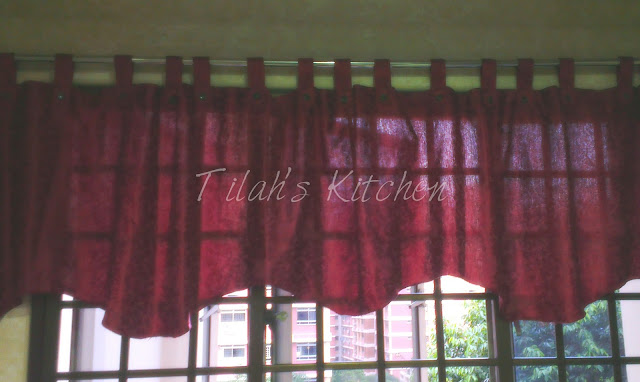Tension Rod - An Alternative to Curtain Rod
Just wanted to share what I did to hang my kitchen window curtain. As you all know, I just moved into my house not long ago. Just last June, to be exact. Basically, I renovated everything in the kitchen which includes the wall and floor tiles. After settling down from moving, my hubby and I had to prepare ourselves for fasting. We were still tired from all the moving and cleaning and decided that once fasting month had started, we will not subject ourselves to any more tiring and hectic work. We basically got everything done up before fasting month except for one thing which we totally forgot, the kitchen window curtain rod.
To get it fixed, it would mean my dear husband having to climb up a ladder and drilling both ends of the walls above the kitchen window. I very much would like to have a curtain up for my kitchen window but could not bear to tire my husband and damage my new kitchen wall tiles. I remembered having came across a site on the internet sometime ago about using tension rod as a curtain rod. So "ka-ching"!
The next moment, we were back from Joo Chiat Complex, the kitchenware shop on the 1st floor. Then "ka-ching"! Like magic, the tension rod was fixed and my curtain was up!
Basically a tension rod uses a spring and a screw to create tension between the rod and the wall. They are fully adjustable as well. The concept is basic. Two pieces of metal or plastic fit inside each other. A coil spring is placed inside the rod and pushes one piece against the other. A screw is used to keep the placement of the coil in the right area so the tension will remain.
Any place that is between two walls or sturdy structures that you want to hang a curtain is a good place for a tension rod. They are most commonly seen in bathrooms. Deep windows that have room in the frame for a tension rod makes hanging curtains very easy. They are also seen in small closets or built in closets instead of doors sometimes too. Measure the area you are wanting to place a rod in before you purchase one. They are available in a variety of size options and you want to make sure you are getting the right one for the best fit. You can also refer to this article to better understand the use of a tension rod.
Any place that is between two walls or sturdy structures that you want to hang a curtain is a good place for a tension rod. They are most commonly seen in bathrooms. Deep windows that have room in the frame for a tension rod makes hanging curtains very easy. They are also seen in small closets or built in closets instead of doors sometimes too. Measure the area you are wanting to place a rod in before you purchase one. They are available in a variety of size options and you want to make sure you are getting the right one for the best fit. You can also refer to this article to better understand the use of a tension rod.
How to Fix It:
1. Attach the curtain or valance to your tension rod by running the rod through the pocket or tab tops at the top of the curtain or valance.
2. Hold the rod to the window, doorway or shower where you will be hanging the curtain. Twist one side of the rod to adjust it to the width of the opening where you plan to put it. Make sure the curtain or valance is still hanging from the tension rod.
3. Place one end of the rod where you would like for it to rest, and push the other end into place. Squeeze the rod together gently, and you'll feel it shorten somewhat as the spring gives. When you place the rod where it belongs, there should be enough resistance from the rod to hold it in place, but you shouldn't have to force it.
4. Twist one end of the rod again, a quarter to a half turn, to make it slightly longer and secure it in place. Spread your curtain or valance evenly along the rod.
2. Hold the rod to the window, doorway or shower where you will be hanging the curtain. Twist one side of the rod to adjust it to the width of the opening where you plan to put it. Make sure the curtain or valance is still hanging from the tension rod.
3. Place one end of the rod where you would like for it to rest, and push the other end into place. Squeeze the rod together gently, and you'll feel it shorten somewhat as the spring gives. When you place the rod where it belongs, there should be enough resistance from the rod to hold it in place, but you shouldn't have to force it.
4. Twist one end of the rod again, a quarter to a half turn, to make it slightly longer and secure it in place. Spread your curtain or valance evenly along the rod.
The left end of the tension rod after fixing.
The right end of the tension rod after fixing.
So, if you don't want to drill and damage your kitchen walls or any other walls of your house and your windows are placed nicely in between two walls, you can consider using tension rod to hang your curtains!
Happy Kitchen-ing!!





Comments